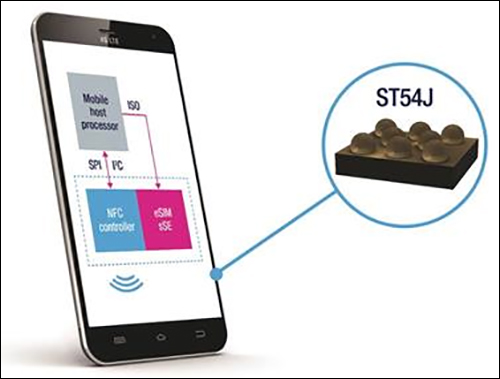STMicroelectronics has released a new Near Field Communication (NFC)-enabled system-on-a-chip (SoC) product intended to make NFC transmissions faster and connectivity more secure. The SoC, known as the ST54J, comes with three products built into a single die: an NFC controller compliant with the ISO 14443 and ISO 15693 protocols, a secure element and an embedded subscriber identity module (eSIM) card for network connectivity. The resulting solution enables all three to be built into a device such as a smartphone, without requiring as much space as would be necessary for the three individual products, according to Christian Vignes, the director of STMicroelectronics’ Mobile Security Business Line.
The new product will allow devices to offer NFC payments or other functionality, without requiring what would otherwise be an off-chip data exchange between an NFC chip and a secure element. The chip operates in three different modes: card emulation, reader-writer and peer-to-peer communication. In card emulation mode, it can be used for mobile payments, transportation or other secure transactions. Reader- writer functionality allows the chip to either send or receive data when tapped against an NFC tag or device. And peer-to-peer communication enables transactions between two devices, such as two mobile phones exchanging photos or business cards.

The secure element, built on the die’s ARM SecurCore 300 core, provides security features to protect the device against advanced forms of attack. It also comes with a large internal shared memory and proper communication interfaces, eliminating the need for an external SIM for memory storage. The chip package measures about 3.5 millimeters by 3.5 millimeters (0.14 inch by 0.14 inch) and approximately 0.41 millimeter (0.02 inch) in thickness. Its compact footprint ensures that it will not interfere with the space needed by the device for battery, the company reports.
The eSIM eliminates the need for a dedicated SIM slot in a phone or other device, thus making the product more water-resistant since it has no physical opening for a SIM card. Additionally, Vignes says, the eSIM being built in reduces the need for physically handling a SIM card or entering a code. “A consumer just downloads the subscription they want” for the phone or device to talk to the network carrier, and can do so even by using a QR code.
Because of the very small size, the phone or other device need not sacrifice battery size to accommodate it, says Thierry Crespo, STMicroelectronics’ manager of NFC and secure mobile marketing. “The footprint is reduced,” he explains, while the RF booster’s ability to improve RF transmission performance allows for a smaller antenna size. The use of the eSIM lets users easily subscribe to and update their subscriptions without any SIM card replacement. For data roaming in other countries, new operator profiles can be loaded onto the eSIM.
STMicroelectronics is working with operating system provider partners that will be building the technology into their own devices. Ultimately, Vignes says, “For consumers, the user experience is improved.” By summer 2019, the company expects to see the technology commercially available in solutions and products.
The firm has also released a tag IC known as the ST25DV-PWM NFC Dynamic, which utilizes RFID transmission to program presets for products on the production line or in use by consumers, in order to simplify the setup process. The NFC and HF ISO 13693 chip will work with any Pulse Width Modulation (PWM)-based controllers, such as lighting products, motorized appliances, fans and thermostats, with an NFC-enabled smartphone or HF 13.56 MHz RFID reader.
Combining STMicroelectronics’ NFC technology with PWM logic, the dynamic tag ICs generate control signals using an embedded pulse-width/period mechanism based on settings received via the RFID interface (which complies with the NFC Type 5 and ISO/IEC 15693 standards) and stored in on-chip electrically erasable programmable read-only memory (EEPROM). The PWM outputs work as soon as the device’s PWM block is powered up, and operate independently from RF activity. To provide further convenience, the PWM configuration can be modified via the NFC interface on the fly, while the device is operating.
The new chip is being offered in two versions: the ST25DV0K-W1 and the ST25DV02K-W2. The former offers single 4mA push-pull PWM outputs for dimming control of an LED light or motor, while the latter feeds up to two LEDs or two motors independently. The chips use the PWM parameters to make changes to a product’s settings during manufacturing, distribution, installation or maintenance.
Samples of the single-output ST25DV02K-W1 and dual-output ST25DV02K-W2 are available now, priced at $0.37 and $0.45 each, respectively, for orders of 1,000 pieces or more. The new products follow the company’s announcement last year of its ST53G system-in-package die that had a built-in secure element and an RF booster, but without the eSIM, for use in watches and other wearable devices (see New System-in-Package Brings NFC Payment to Wearables).

